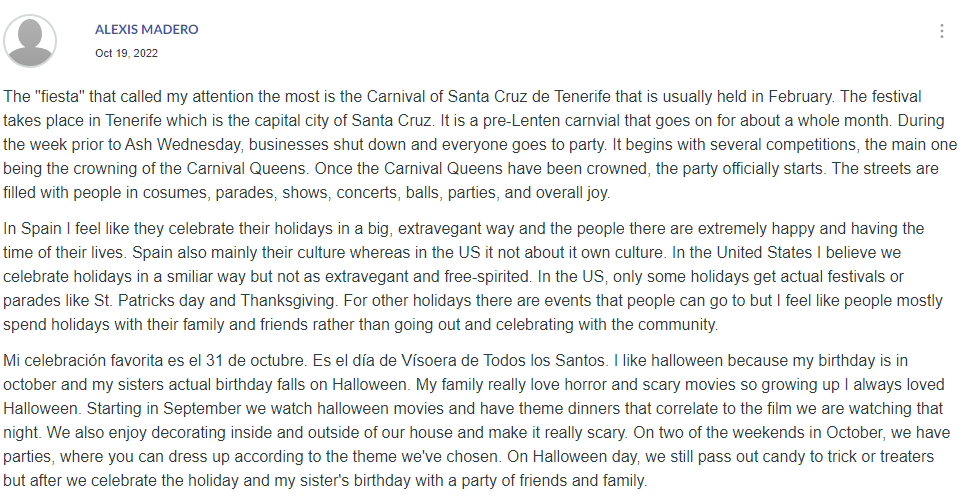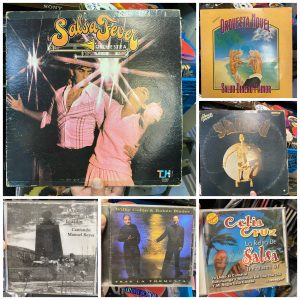Interpretive, Interpersonal, and Presentational Modes of Communication
Exploring Culture
For Spanish 101, the main product that helped me gain an understanding of cultural perspectives was the online textbook, Contrasena. The textbook is a digital book that allows you to interact while learning. A practice that also help deepen my understanding was the discussion boards that had YouTube attachments of the hispanic culture.
These products and practices helped me better understand values and attitudes in the Hispanic culture by revealing their beliefs, morals, and way of living. In the Hispanic culture, family is a immense thing in life, whereas in the american culture, it is not as important. In America, I believe more people spend time with their friends rather than family. Another example is in the Hispanic culture, they are more affectionate and display affection to strangers. For one of our discussion boards we watched a video about Spaniards and Latin Americans meeting people for the first time. We were then asked if we would feel comfortable greeting strangers the same way. When Hispanics greeting people or saying goodbyes, they will kiss eachothers cheeks while giving hugs. In their culture, it is normal as shaking ones hand in America.
Contrasena and the discussion boards challenged my worldview by showing me that each culture is drastically different. In the Hispanic culture, they have different beliefs, food, religion, greetings, way to display respect, and even they way the speak. For a discussion, we discussed the different holidays and festivals held in Spain and how they differ from how Americans celebrate holidays. Before the discussion, I thought most countries celebrated the same holidays as us and in a similar way. However, I was mistaken, and in the Hispanic culture there are more celebrations about their previous history, and everyone comes together to celebrate. Before starting this course, I was unaware of the small aspects of cultural differences. I have now gain new knowledge about the Hispanic culture and how it differs from other cultures.
Engaging in Communities
It is immersely essential to engage with your immediate community as well as the global community. By connecting with your community, you are able to develop a deeper understanding of the issues that surround your community or the global community. When interacting with communities you are introduced to various people with diverse backgrounds. I find this valueable because you are able to gain knowledge and have an understanding of the different ways people live and their beliefs.
This semester I have developed a community with my fellow classmates. To discuss our perpectives on certain topics, like favorite holidays, we would do so by completing discussion boards. For my artifacts, I included a discussion about what fiesta in Spain caught our attention and what is our favorite holiday in America. This is an example of communicating with my community because I am sharing my opinions with my classmates, who have similar goals and interest as me. It is difficult in a community because you may feel like you have different views than others, and will be judged for it. However, we were accepting of different viewpoints and listen to peoples reasonings. When having discussion, you can further your knowledge on the topics discussed, since this give everyone a chance to say their opinions and why.
Interpersonal Communication
Interpersonal communication that was used to help with my Spanish learning would be the discussion boards and the oral exams. For the discussion boards, I was able to communicate with my classmates. The oral exams helped me in more depth, since I had to review all the information we were given and have an actual conversation with the professor.
The discussions and a few of the Flipgrid assignments was were we had the most interpersonal communication activites. For the discussion boards, we would either answer a question or do research on hispanic culture. I enjoyed the discussions because I was able to see things from different perspectives. In contrast with discussion boards, for the oral exam it is a nonscripted conversation with the professor over Zoom. The oral exam helped me to form proper and correct sentences when speaking to another and to understand questions being asked or statements being stated. My biggest difficulty was remebering to change the way sentences are formed in Spanish. For example, if I am describing someone in Spanish, the discriptive work goes after the person. To help with the difficulty, I had to contantly practice forming sentences, whether writing or speaking. On the contrary, I exceled at knowing what to say and how to pronounce many words correctly. I knew my answers for the questions, just not how to properly form them. Since the constant practice with Contrasena, I memorized numerous vocabulary words and how grammer works in Spanish. One thing I would do differently would be to hold more conversation in Spanish while taking the class. I believe if I had practice speaking with other more I would gain the understanding of the Spanish language easier and quicker. Within each assingment, I have expanded my understanding for cultural differences and how different perspectives are looked at. Additionally, I have increased my knowledge of the spanish language to be able to hold a proper conversation with others.
Presentational Speaking
In class we used Flipgrid, which is an application where you are able to post videos of yourself answering the professors questions or fill in the blank videos. We used Flipgrid for a fill-in-the-blank videos, where our professor post a video of her part of the conversation. We then reply to the post by recording ourselfs finishing the conversation in spanish.
In the video, I am having a conversation with my professor in spanish about classes and living. My main difficulty when working on this would be the trying to keep up with the conversation. While recording and listening to her audio, I would first have to think about what she said then come up with a reply. While working on this, I would do it without my notes, so I did take me longer to complete the assignment and I had to redo the video multiple times. After the first few times of listening and trying to conversate, I was able to clearly understand what she was saying and asking, as well as coming up with answers. Next time I would listen to the audio first to understand what is being told, then look at my notes to get a better understanding, and then try to answer with better and thoughtful responces.
Presentational Writing
Outside of class, I created a brochure in spanish about my made-up university. I created this brochure to help me learn some vocab words and how to form sentences in a formal way. Inside of class, we had a research disscusion about universities in Spain and how they differ from Old Dominion University.
Madero-UniversidadIn the first artifact I included, I did outside of class to gain a better understanding of new vocabulary words and how to make sentences with them. I created a brouche of a made-up school and talked about special buildings in the school, like the library and the labatory, in spanish. For the discussion board read and article and watch a video explain the universities in Spain. From thoes resources, we then had to compare the University to ODU. The discussion, as long with a few assignments from Contrasena, I was able to grow my ability to research Hispanic topics. Instead of just searching things in english, I can also include the spanish equivalent wordings. Or I can compare and contrast my result from searching in english and searching in spanish.
When searching for information in spanish, it was difficult to understand the information presented and difficult to find the answers I was looking for. As stated previously, looking for context clues has help. When using the context clues it made researching in spainsh easier beacuse I was able to understand what I was reading, and could find the information I was looking for. Next time I could use more than one spanish refrence and do more comparing and contrasting from english and spanish articles.
Interpretive Listening
A type of interpretive listening that I have done outside of class to help my learning in Spanish would be listening to spanish music. My family owns various old spanish songs and records, so I listen to them just about everyday.
Oye Como Va, is one of the main songs that play in my house and that I have listened to outside of class. Although they are not saying much in the song, I love to listen to it to appriciate all the instruements used and how they sound beautiful together. Along with Santana, I listen to many other artists like, Lola Flores, Selena, Bad Bunny, J Balvin, and etc.
During this semester, I have listen to various spanish music, mostly outside of class. What I struggled with the most was understanding the music. To help with my learning experience, when listening to spanish music I would first ask my Ecuadorian grandfather to explain and then I would look up the lyrics. I was very intrested that when many songs are translated to English they don’t really make sense, however, in spanish it does. My takeaway from the listening experience is that cultural perspective is important. One person may feel a different way towards a song than someone else, based on their perspective. Furthermore, people can also portray songs differently.
Interpretive Reading
Interpretive communication activites that I have participated in class would be lessons on contsentra, and discussions that have links to other websites. An activity I participated outside of class would be Duolingo stories.
In the activites in contsentra, we would read small paragraphs and answer questions about the reading. For me, the challenging part was to understand the sentences I was reading. I overcame this difficulty by trying to look for context clues. So if I was unclear of a sentence, I would see words I do know and slowly piece everything together. For Duolingo, I am able to read short stories, with words I already know, and asked questions as the story is going on. This was very helpful in my learning process because i was able to be repetitive with the vocab words and have them in proper sentences. Another thing that helps on Doulingo is that I am able to click on the words if I don’t know what it is, to get a clearer meaning of the sentence. I found it intresting that I was able to read stories and understand them without having to know every word. With each assignment I have completed, I have grown my knowledge and understanding of the spanish language and the hispanic culture. I have a better comprehension of how to use and incorporate the Spanish language in my everyday life.



